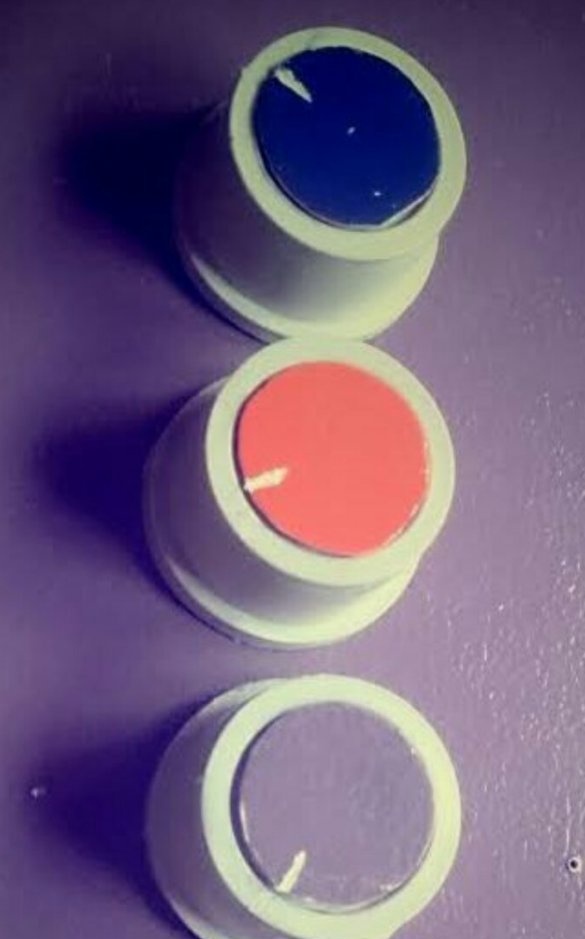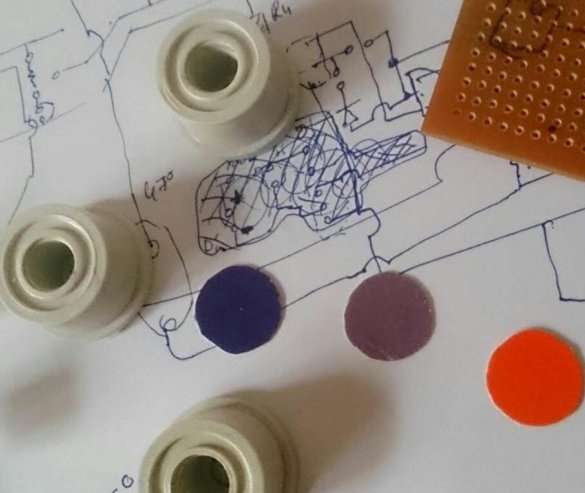Yes, handles for variable resistors can be bought in the same place as the resistors themselves. But the author of Instructables under the unusual nickname aaaaoooo suggests making them from hollow legs for cases. Handles made of legs. The original pun doesn't work: knobs and feet.
The master begins by sticking a paper circle on the leg, the color of which is chosen arbitrarily. Then he flips the handle hollow part up:
Tape the shaft of the potentiometer with thin paper so that it fits snugly and can be easily separated. Masking tape is undesirable, it is not very thin. It is better to stick, for example, newsprint with glue and pencil. The variable resistor should be with the same shaft (this applies both to the diameter and shape), as for the other variable resistors for which you are going to make handles.
The master fills the cavity in the leg with hot glue. Turns over the variable resistor, and, while the glue is diluted, dip the paper pasted shaft there, making sure that its axis coincides exactly with the axis of the leg. Preventing shaft displacement, holds the resistor until the hot melt cools so much that it begins to hold the shaft itself. Then it waits for the glue to cool to room temperature.
It pulls out a variable resistor from the resulting handle. The paper remains firmly tacky to the inner walls of the hole for the shaft formed from hot-melt adhesive. If you now put the handle back on the shaft, it can slip. Therefore, the master puts on a shrink tube, preferably thin-walled, on the shaft and heats it so that it shrinks. After this operation, the handle can be repeatedly put on the shaft and removed from it - it will not slip.
The master puts the handle on the shaft, expands the variable resistor with the shaft toward him and the leads down, and then rotating the shaft counterclockwise by the handle, puts the resistor in the position corresponding to the minimum. Puts a mark on the paper circle pointing down and slightly to the left. Moves the variable resistor to the position corresponding to the maximum, and makes sure that the mark is now directed down and slightly to the right. Wraps the paper circle with two layers of transparent adhesive tape, instead of which you can also apply a suitable varnish.If you make a circle not of paper, but of foil, you can not draw a label on it, but squeeze it out.
Some craftsmen make handles for variable resistors in approximately the same way, but instead of legs for housings, they take hollow aluminum cylinders from electrolytic capacitors that have failed. Exempt the cylinder from heat shrinkage marked if the capacitor is modern. The mark is applied using a core or microdrills. But you never know how many more, it would seem, unnecessary hollow cylindrical objects each has. Caps from various tubes, caps from bottles - all this is suitable for the manufacture of pens for variable resistors, if you form a hole for the shaft using hot-melt adhesive and choose the appropriate labeling method. A pretty vintage-looking pen can be made from the cap from an empty bottle from the “Bar” means, after removing the rod with a brush.


